In This Article:
- 5 Key Points
- Anatomy of the Chest Wall
- Indications for Reconstruction
- Principles of Chest Wall Reconstruction
- Assessment of Chest Wall Defects
- Skeletal Stabilisation of the Chest Wall
- Soft Tissue Coverage of Defects
- References
5 Key Points
- Anatomy of Chest Wall Reconstruction focuses on the 3 layers of muscles; blood supply from the aorta, subclavian and axillary arteries; innervation from intercostal nerves.
- The most common indications of reconstruction are congenital, infectious, inflammatory, trauma, and malignancy.
- Assessment of Defects should focus on the defect (size, location, and depth), surrounding tissue, and patient factors.
- Skeletal Reconstruction is considered for a subset of patients and can involve autologous or alloplastic materials.
- Soft Tissue Reconstruction is most commonly a regional pedicled muscular flap but this depends on the defect and its location.
Anatomy of the Chest Wall
A detailed review of chest wall anatomy is outside the scope of this article. These are the important points relevent to chest wall reconstruction.
There are 3 main anatomical areas to be aware of in chest wall reconstruction: muscles, blood supply, nerve innervation.
Muscles of Chest Wall
The muscles of the chest wall either make up the thoracic cage or insert onto it.
- Thoracic cage muscles are intercostals (external, internal, and innermost), subcostals, and transversus thoracis.
- Muscles that insert into the thoracic cage include Pectoralis major and minor, Serratus anterior, Scalene muscles.
The "thoracic cage muscles" play an important role in respiratory mechanics.
Neurovascular Supply
The arterial blood supply of the chest wall can be simplified into two sources:
- Originates from Aorta: these are paired intercostal arteries, which travel through the intercostal spaces and join the internal mammary arteries.
- Originates from subclavian & axillary arteries: these include the thoracoacromial, lateral thoracic, and thoracodorsal branches.
The venous drainage runs in parallel to the arterial supply (except for the intercostal veins draining into the azygous in the posterior mediastinum).
There are motor and sensory nerve paired intercostal nerves. They link to the anterior rami of the T1 to T11 to innervate the intercostal muscles and overlying skin.
Indications for Reconstruction
Chest wall reconstruction is commonly performed for congenital or acquired reasons. These can relate to malignancy, infection, radiation, trauma, or functional.
Here is a list of potential indications for chest wall reconstruction.
- Congenital: Pectus Excavatum, Carinatum, Poland Syndrome.
- Infectious/Inflammatory: Radiation Necrosis, Osteomyelitis, Empyema, Bronchopleural fistula, post-sternotomy.
- Trauma: flail chest (fractures of 3 adjacent ribs in 2 or more places)
- Malignancy: Primary or Secondary/direct invasion from surrounding tissues.
Principles of Chest Wall Reconstruction
The goal of chest wall reconstruction is to achieve biomimesis1. This can be done by adhering to the following principles of chest wall reconstruction:
- Respect the anatomy
- Maintain skeletal support and chest wall stability
- Provide well-vascularised soft-tissue coverage
- Preserve pulmonary mechanics and function
- Protect intrathoracic organs & obliterate dead space
- Multi-disciplinary approach to debridement and reconstruction.
- Achieve aesthetic results.
These principles have developed over the past 100 years. The first reported case of chest wall reconstruction was by Tansini in 190611. Tansini described the use of a pedicled latissimus dorsi for coverage of an anterior thoracic defect. It's in Italian, but here are images from a Lancet Publication referencing the original work.
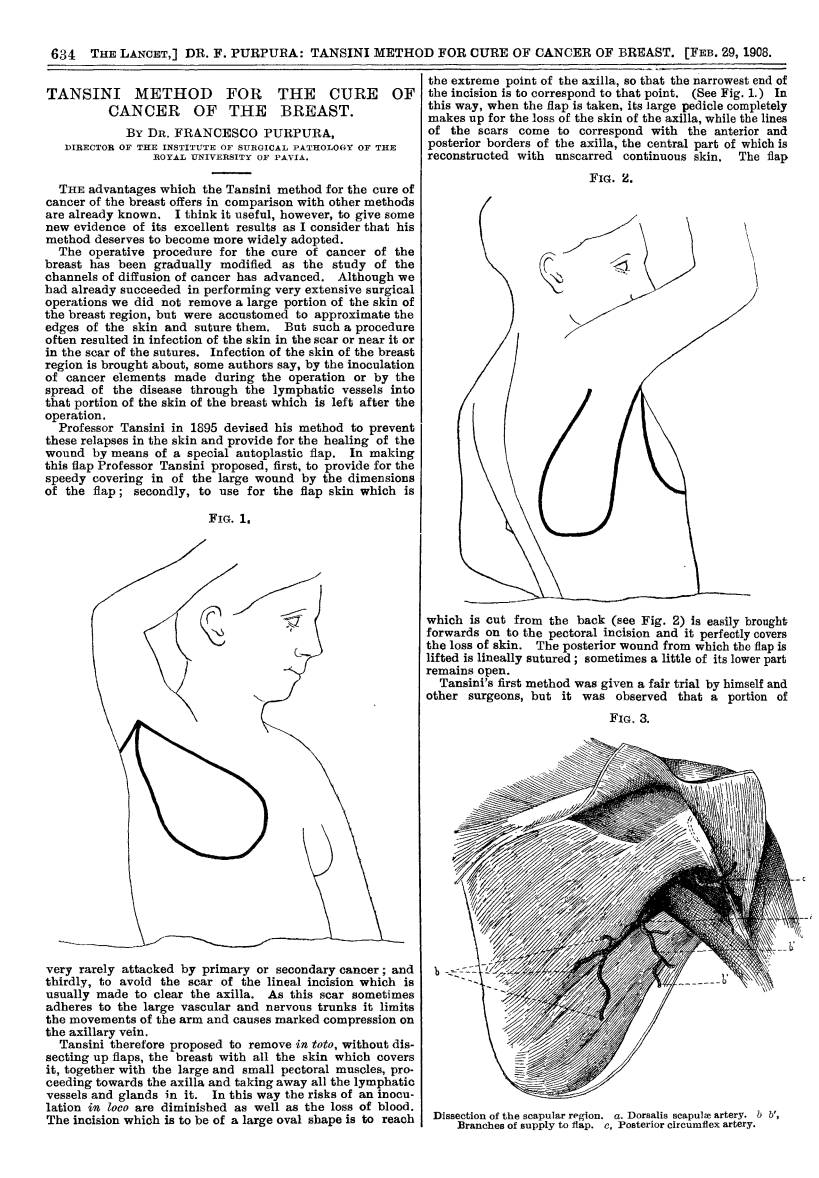
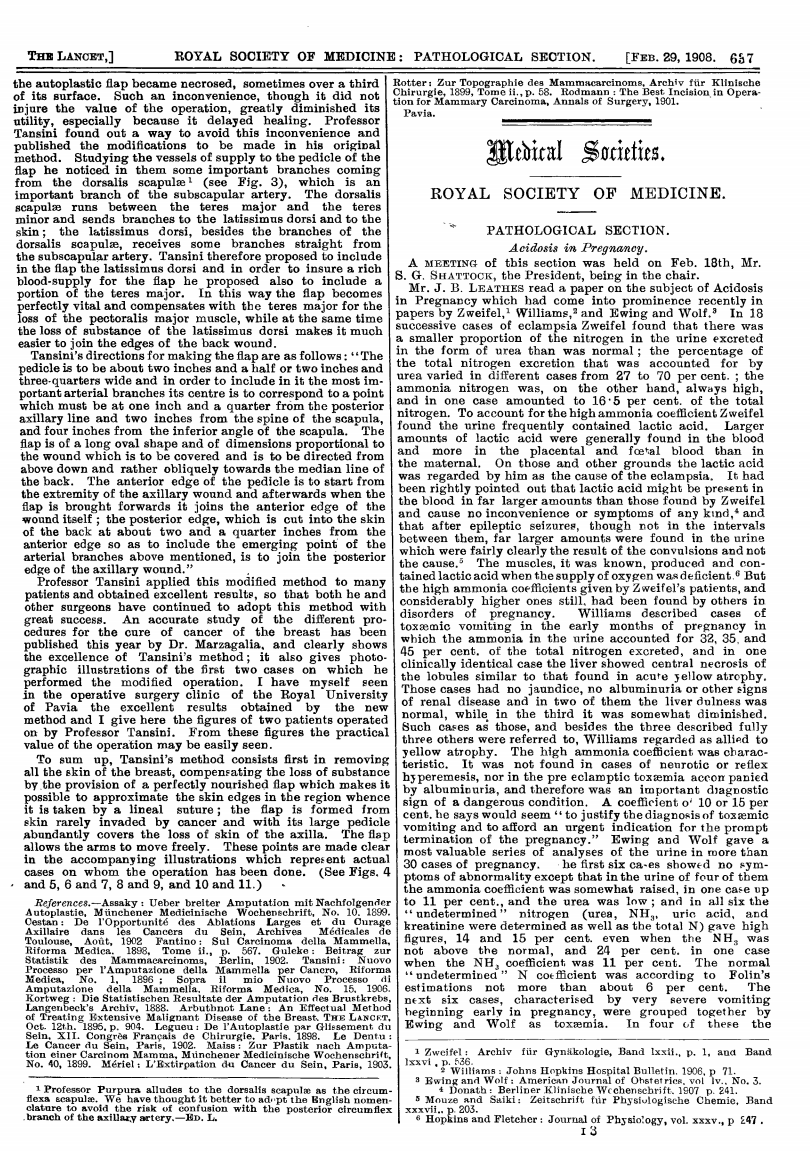
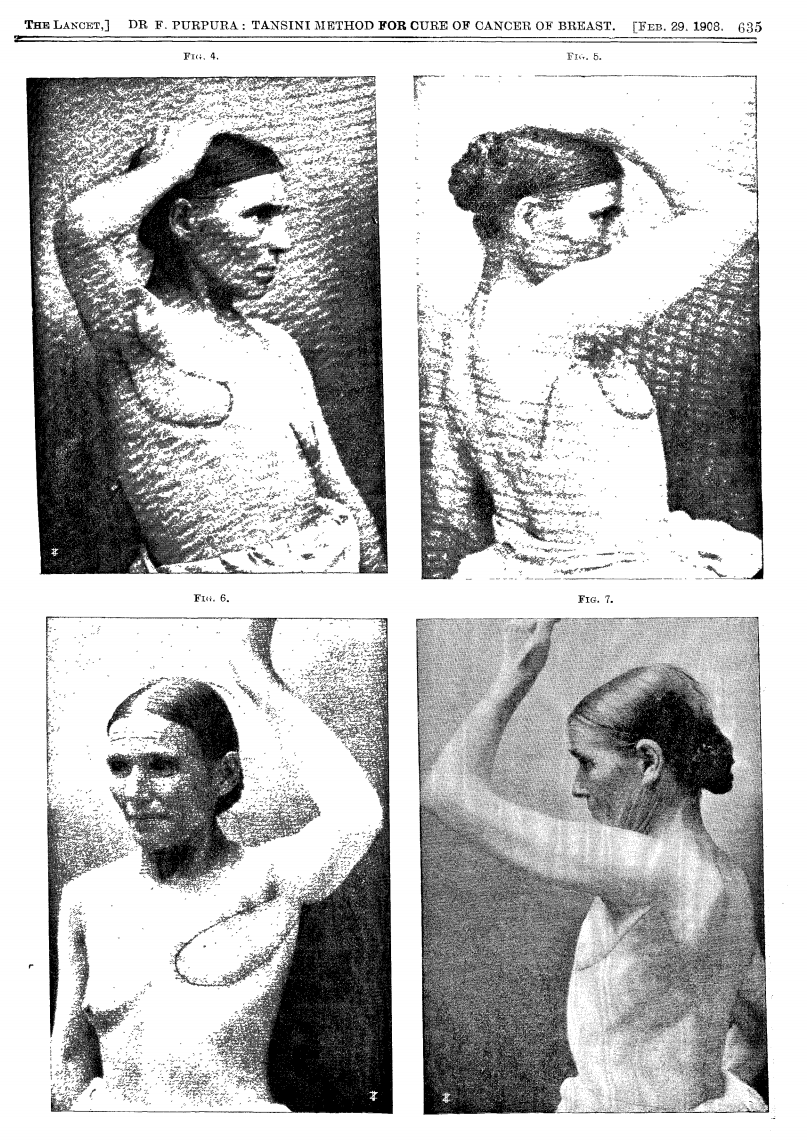
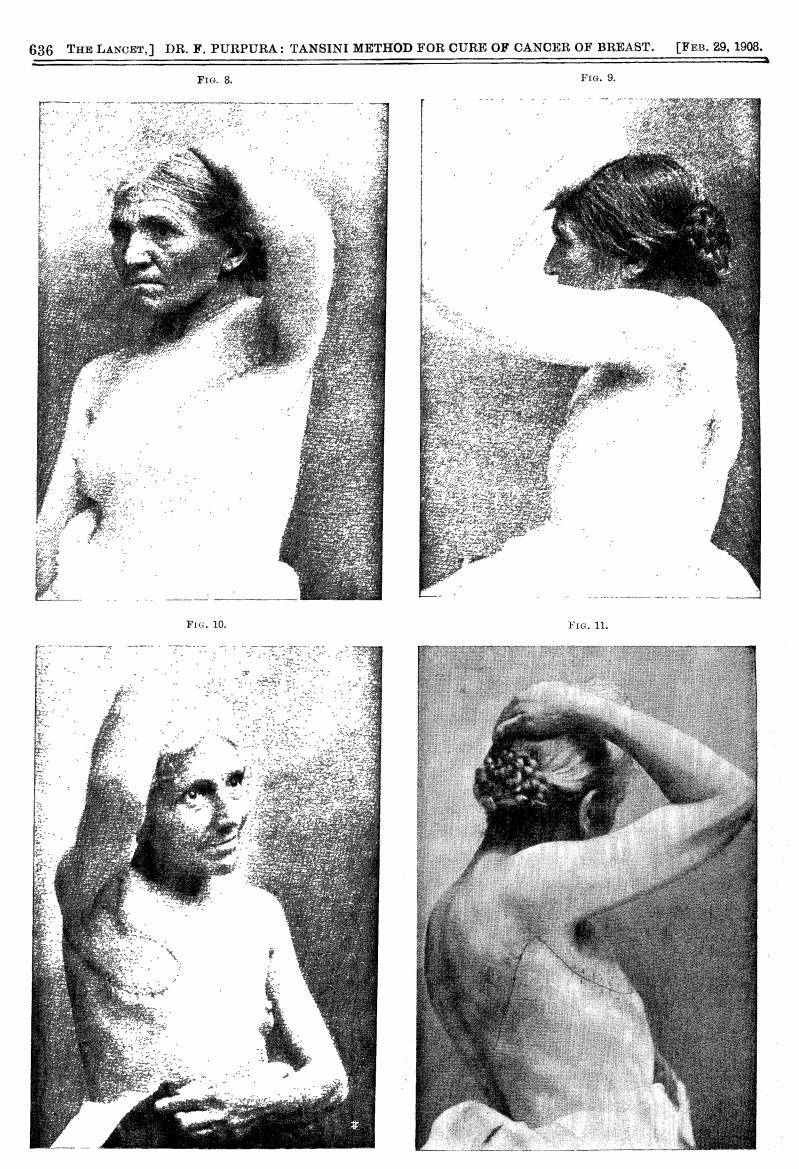
1908 Lancet Publication translating the work of Tansini
Assessment of Chest Wall Defects
The assessment of the chest wall defect can be simplified into defect (size, location and depth), surrounding tissue, and patient factors - in a multidisciplinary team.
Defect: Size, Location, and Depth
The reconstruction decision algorithm is strongly influenced by the size, location, and depth of the chest wall defect.
In terms of location:
- Anterolateral defects are more likely to impact respiratory mechanics, and therefore it's important to reestablish structural support. The lack of sternal or spinal stability in that location renders the patient more prone to flail chest deformities.
- Anterior Defects are often suitable for Latissimus Dorsi or Pectoralis Flaps.
- Supero-posterior defects often don't require skeletal stabilisation due to the support provided by the scapula and shoulder girdle.
In terms of depth:
- Partial Thickness Defects sometimes only require a skin graft.
- If a full-thickness defect, it may require skeletal stabilization
Surrounding Tissue
The quality of the surrounding tissue also guides the decision-making process. For example:
- An infected area may require a two-stage operation.
- A radiated area should have a well-vascularised soft-tissue coverage from outside the zone of radiation
- A cancer resection requires negative oncological margins.
- Assessment of dead space or exposed organs.
Importantly, irradiated tissues are stiffer but less likely to have paradoxical chest movements post-resection.
Patient Factors
The most important person in the multi-disciplinary team. A detailed assessment should determine:
- Suitability for surgery (pulmonary, cardiovascular, and nutritional health)
- Prior surgery to see suitability for reconstructive options or previous CABG (will have taken the internal mammary artery).
- The role of adjuvant radiotherapy (to help decide appropriate soft tissue coverage)
Skeletal Stabilisation in Chest Wall Reconstruction
This is one of the most important questions to ask - does this defect require skeletal stabilization? Numerous factors influence the decision process regarding which defects required skeletal reconstruction.
Indications of Stabilisation
The traditional doctrine states that a deficiency of 2 ribs can be compensated by adequate soft tissue reconstruction2. Most surgeons agree that defects should be reconstructed if2-5:
- >5 cm in diameter
- >4 consecutive ribs
This is due to the high risk of lung herniation and respiratory compromise from the paradoxical motion of the chest wall. This is particularly true for anterolateral defects and full-thickness resections.
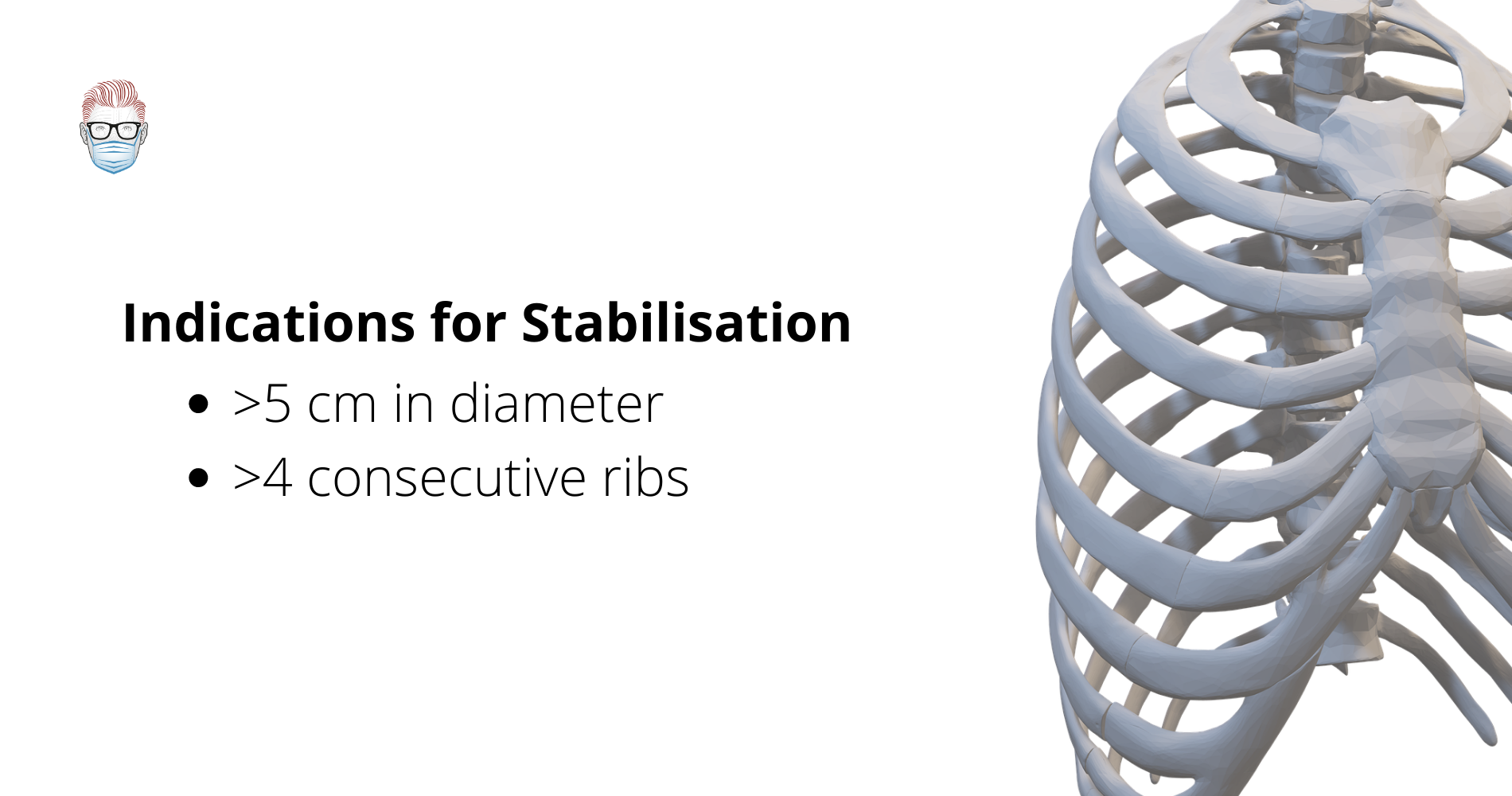
It is important to note, this is not a set rule. For example, some surgeons:
- Do not reconstruct large apicoposterior defects because of the support provide by scapula and shoulder girdle6.
- Do not expect flail chest or respiratory insufficiency post-sternectomy or resection of 4–6 ribs at the cartilage level6.
- Do reconstruct nearly all chest wall defects, with the objective to avoid the patient perception of chest wall instability due to the increased availability of reconstruction materials8
Skeletal Reconstruction Options
The choice of prosthetic material is usually based on surgeons' preference. The ideal characteristics of prosthetic material for chest wall reconstruction include rigidity, malleability, inertness, and radiolucency9.
Options for skeletal reconstruction include either autogenous or alloplastic reconstruction. Autologous materials for structural repair are rarely used nowadays (split rib grafts, iliac crest, fibula).
In terms of Alloplastic materials, it includes:
- Vicryl, Prolene, or Marlex mesh: semi-rigid, can fragment.
- Polytetrafluoroethylene (Gore-Tex): malleable, expensive.
- Composite of mesh and methyl methacrylate12: rigid, higher infection rates.
- Titanium Plates: provides true fixation, earlier mobilisation.
- Acellular Dermal Matrix: less likely to become infected
Each prosthetic material has its own advantages and disadvantages and none have proven to be clearly superior12,13. A detailed review of these types of alloplastic materials is outside the scope of this article.v
Soft-Tissue Reconstruction of the Chest
The main reconstructive choice for chest wall reconstructon is muscle or musculocutaneous flaps. Defects not involving the full thickness may be suitable for skin grafting or local skin flaps.
Latissimus Dorsi (LD) Flap
The Latissimus Dorsi (LD) Flap is considered a "workhorse" for chest wall reconstruction10. It is classified as Mathes and Nahai Type 5 Muscle Flap.
The main points in relation to this are:
- Tissue: muscle or myocutaneous flap.
- Pedicle: dominant thoracodorsal pedicle.
- Location of Defect: anterior & anterolateral defects, but is successful in all defect locations14.
- Variations: the subscapular trunk, from which the thoracodorsal artery derives, allows chimeric flap to be raised (LD, serratus anterior, and a skin island based on the circumflex scapular vessels). The serratus anterior is a Mathes and Nahai Type 3 Muscle Flap.
Pectoralis Major Flap
The pectoralis major is considered the principal flap for sternal and anterosuperior chest wall defect coverage7,15,16. It can be an advancement, turnover, or composite myocutaneous. It is classified as Mathes and Nahai Type 5 Muscle Flap.
Key points for chest wall reconstruction are:
- Pedicle: dominant thoracoacromial pedicle, or 1-6 intercostal perforating branches. This dual vascular pattern allows the use of only the medial two-thirds of muscle, which spares lateral 1/3 and anterior axillary fold.
- Location: Sternal (via the "turnover flap") and anterosuperior chest wall.
- Variations: release of muscle from its bony connections allows mobilisation of the flap to the xiphoid process.
Greater Omentum
The greater omentum is often used as a salvage procedure. It is well-vascularised tissue suitable for areas of radiation damage or infection. It was first described by Jurkiewicz in 197717. Key points for chest wall reconstruction are:
- Pedicle: Usually transferred on the right gastroepiploic artery.
- Location: Anterior chest wall
- Negatives: An upper laparotomy incision is needed for access into the peritoneal cavity, which can lead to possible GI complications (hernia, obstruction, adhesions)
Additional Flaps
There is a large selection of flaps to consider. Other flap reconstruction options include:
- Rectus abdominis for sternal wounds (pedicled VRAM/TRAM)
- Free Tissue Transfer can be used in most chest wall locations when local/regional options are not available.
- Breast sharing for sternal wounds18
- External oblique as a myocutaneous flap19,20.
- Serratus Anterior by itself or combined with LD flap.
References
- Rocco G: Chest wall surgery. Thorac Surg Clin 20:xiii, 2010 2. Rocco G: Overview on current and future materials for chest wall reconstruction. Thorac Surg Clin 20:559-562, 2010
- Din AM, Evans GR. Chest wall reconstruction. In: McCarthy JB, Galiano RD, Boutros S, editors. Current therapy in plastic surgery. Philadelphia: Saunders; 2006. p. 362
- Seder CW, Rocco G. Chest wall reconstruction after extended resection. J Thorac Dis 2016;8:S863-S871.
- Ferraro P, Cugno S, Liberman M, et al. Principles of chest wall resection and reconstruction. Thorac Surg Clin 2010;20:465-73.
- Mahabir RC, Butler CE. Stabilization of the chest wall: autologous and alloplastic reconstructions. Semin Plast Surg 2011;25:34-42.
- Deschamps C, Tirnaksiz BM, Darbandi R, et al. Early and long-term results of prosthetic chest wall reconstruction. J Thorac Cardiovasc Surg 1999;117:588-91. 13.
- Arnold PG, Pairolero PC. Chest wall reconstructions: an account of 500 consecutive cases. Plast Reconstr Surg 1996; 98(5):804
- Rocco G. Chest wall resection and reconstruction according to the principles of biomimesis. Semin Thorac Cardiovasc Surg 2011;23:307-13.
- A reconstructive algorithm for plastic surgery following extensive chest wall resection A. Loskena,*, V.H. Thouranib , G.W. Carlsona , G.E. Jonesa , J.H. Culbertsona , J.I. Millerb , K.A. Mansourb
- Bostwick J, Nahai F, Wallace JG, et al. Sixty latissimus dorsi flaps. Plast Reconstr Surg 1979;63:31.
- Tansini I. Sopra il mio processo di amputazione della mammella. Gazz Med Ital Torino 1906;57:141 [in Italian]
- Deschamps C, Timaksiz BM, Darbandi R, et al. Early and long term results of prosthetic chest wall reconstruction. J Thorac Cardiovasc Surg 1999;117:588.
- Weyant MJ, Bains MS, Venkatraman E, et al. Results of chest wall resection and reconstruction with and without rigid prosthesis. Ann Thorac Surg 2006;81:279-85.
- Losken A, Thourani VH, Carlson GW, Jones GE, Culbertson JH, Miller JI, Mansour KA. A reconstructive algorithm for plastic surgery following extensive chest wall resection. Br J Plast Surg. 2004 Jun;57(4):295-302. doi: 10.1016/j.bjps.2004.02.004. PMID: 15145731.
- Jones G, Jurkiewicz MJ, Bostwick J, et al. Management of the infected median sternotomy wound with muscle flaps. The Emory 20-year experience. Ann Surg 1997;225:766.
- Nahai F, Morales L Jr, Bone DK, et al. Pectoralis major muscle turnover flaps for closure of the infected sternotomy wound with preservation of form and function. Plast Reconstr Surg 1982;70:471
- Jurkiewicz MJ, Arnold PG. The omentum: an account of its use in reconstruction of the chest wall. Ann Surg 1977;185:548.
- Design of the ‘cyclops flap’ for chest wall reconstruction Hughes KC. Plast Reconstr Surg 1997;100:1146–1151.
- Bogossian N. Plast Reconstr Surg 1996;97:97–103.
- Moschella F (Plast Reconstr Surg 1999;103:1378– 1385)


